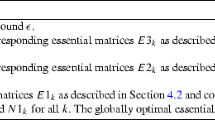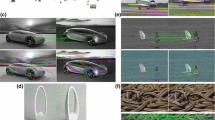Abstract
In this paper we will discuss structure and motion problems for curved surfaces. These will be studied using the silhouettes or apparent contours in the images. The problem of determining camera motion from the apparent contours of curved three-dimensional surfaces, is studied. It will be shown how special points, called epipolar tangency points or frontier points, can be used to solve this problem. A generalised epipolar constraint is introduced, which applies to points, curves, as well as to apparent contours of surfaces. The theory is developed for both continuous and discrete motion, known and unknown orientation, calibrated and uncalibrated, perspective, weak perspective and orthographic cameras. Results of an iterative scheme to recover the epipolar line structure from real image sequences using only the outlines of curved surfaces, is presented. A statistical evaluation is performed to estimate the stability of the solution. It is also shown how the motion of the camera from a sequence of images can be obtained from the relative motion between image pairs.
Similar content being viewed by others
References
Åström, K. 1996. Invariancy methods for points, curves and surfaces in computational vision. Ph.D. thesis, Department of Mathematics, Lund University, Sweden.
Åström, K., Cipolla, R., and Giblin, P.J. 1996. Generalised epipolar constraints. In Proc. 4th European Conf. on Computer Vision, B. Buxton and R. Cipolla (Eds.), vol. 1065 of Lecture notes in Computer Science, Springer-Verlag: Cambridge, UK, pp. 97–108.
Åström, K. and Heyden, A. 1999. Stochastic analysis of scale space smoothing. Advances of Applied Probability.
Blake, A. and Yuille, A.L. (Eds.). 1992. Active Vision, MIT Press: Cambridge, Massachusetts, London, England.
Bruce, J.W. and Giblin, P.J. 1992. Curves and Singularities, 2nd edition, Cambridge University Press.
Carlsson, S. 1994. Sufficient image structure for3Dmotion and shape estimation. In Proc. 3rd European Conf. on Computer Vision, J.-O. Eklundh (Ed.), Springer-Verlag: Stockholm, Sweden, vol. I, pp. 83–91.
Cipolla, R. 1991. Active visual inference of surface shape. Ph.D. thesis, University of Oxford. Also published in Springer-Verlag as LNCS 1016 (1995).
Cipolla, R., Åström, K., and Giblin, P.J. 1995. Motion from the frontier of curved surfaces. In Proc. 5th Int. Conf. on Computer Vision, MIT: Boston, MA, pp. 269–275.
Cipolla, R. and Blake, A. 1990. The dynamic analysis of apparent contours. In Proc. 3rd Int. Conf. on Computer Vision, Osaka, Japan, pp. 616–623.
Cipolla, R. and Blake, A. 1992. Surface shape from the deformation of apparent contours. Int. Journal of Computer Vision, 9(2):83–112.
Cipolla, R., Fletcher, G., and Giblin, P. 1996. Following cusps. Int. Journal of Computer Vision.
Coxeter, H.S.M. 1993. The Real Projective Plane, 3rd edition, Springer-Verlag: New York, NY, USA.
Curwen, R. and Blake, A. 1992. Dynamic contours: Real-time active splines. In Active Vision, A. Blake and A. Yuille (Eds.), MIT Press, pp. 39–58.
Faugeras, O. 1993. Three-Dimensional Computer Vision. MIT Press: Cambridge, Mass.
Faugeras, O.D. 1992. What can be seen in three dimensions with an uncalibrated stereo rig? In Proc. 2nd European Conf. on Computer Vision, G. Sandini (Ed.), Springer-Verlag: Santa Margherita Ligure, Italy, pp. 563–578.
Faugeras, O.D., Luong, Q.-T., and Maybank, S. 1992. Camera selfcalibration: Theory and experiment. In Proc. 2nd European Conf. on Computer Vision, G. Sandini (Ed.), Springer-Verlag: Santa Margherita Ligure, Italy, pp. 321–334.
Fletcher, G. 1996. Curves and surfaces. Ph.D. thesis, Department of Pure Mathematics, Liverpool University, UK.
Foley, J.D., van Dam, A., Feiner, S.K., and Hughes, J.F. 1990. Computer Graphics, Principles and Practice. Addison-Wesley Publishing Company.
Giblin, P.J., Pollick, F.E., and Rycroft, J.E. 1994. Recovery of an unknown axis or rotation from the profiles of a rotating surface. J. Opt. Soc. America, 11(A):1976–1984.
Giblin, P.J. and Weiss, R. 1987. Reconstruction of surfaces from profiles. In Proc. 1st Int. Conf. on Computer Vision, London, pp. 136–144.
Giblin, P.J. and Weiss, R.S. 1995. Epipolar curves on surfaces. Image and Vision Computing, 13:33–44.
Heyden, A. and Åström, K. 1997. Simplifications of multilinear forms for sequences of images. Image and Vision Computing, 15(10):749–757.
Joshi, T., Ahuja, N., and Ponce, J. 1995. Structure and motion estimates from dynamic silhouettes under perspective projection. In Proc. 5th Int. Conf. on Computer Vision, MIT: Boston, MA, pp. 290–295.
Kass, M., Witkin, A., and Terzopoulos, D. 1987. Snakes: Active contour models. Int. Journal of Computer Vision, 1(4):321–331.
Koenderink, J.J. 1990. Solid Shape. MIT Press.
Longuet-Higgins, H.C. 1981. A computer algorithm for reconstructing a scene from two projections. Nature, 293:133–135.
Luenberger, D.G. 1984. Linear and Nonlinear Programming. Addison-Wesley.
Luong, Q.T., Deriche, R., Faugeras, O.D., and Papadopoulo, T. 1993. On determining the fundamental matrix: Analysis of different methods and experimental results. Technical Report RR-1894, INRIA.
Luong, Q. and Vieville, T. 1994. Canonic representations for the geometries of multiple projective views. In Proc. 3rd European Conf. on Computer Vision, Stockholm, Sweden, pp. 589–599.
Porrill, J. and Pollard, S.B. 1991. Curve matching and stereo calibration. Image and Vision Computing, 9(1):45–50.
Rieger, J.H. 1986. Three dimensional motion from fixed points of a deforming profile curve. Optics Letters, 11:123–125.
Sinclair, D., Christiansenn, H., and Rothwell, C. 1995. Using the relation between a plane projectivity and the fundamental matrix. In Proc. 9th Scandinavian Conference on Image Analysis, pp. 181–188.
Stefanovic, P. 1973. Relative orientation—a newappraoch. ITC Journal, 3:417–448.
Thompson, E.H. 1959. A rational algebraic formulation of the problem of relative orientation. Photogrammetric Record, 14(3):152–159.
Vaillant, R. and Faugeras, O.D. 1992. Using extremal boundaries for 3D object modelling. IEEE Trans. Pattern Analysis and Machine Intelligence, 14(2):157–173.
Vijayakumar, B., Kriegman, D., and Ponce, J. 1995. Invariant-based recognition of complex 3D curved objects from image contours. In Proc. 5th Int. Conf. on Computer Vision, MIT: Boston, MA, pp. 508–514.
Vijayakumar, B., Kriegman, D., and Ponce, J. 1996. Structure and motion of curved 3D objects from monocular silhouettes. In Proc. Conf. Computer Vision and Pattern Recognition, pp. 327–334.
Author information
Authors and Affiliations
Rights and permissions
About this article
Cite this article
Åström, K., Cipolla, R. & Giblin, P. Generalised Epipolar Constraints. International Journal of Computer Vision 33, 51–72 (1999). https://doi.org/10.1023/A:1008113231241
Issue Date:
DOI: https://doi.org/10.1023/A:1008113231241




